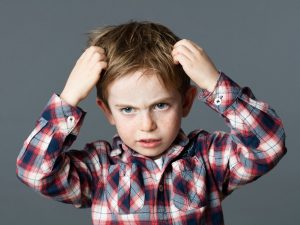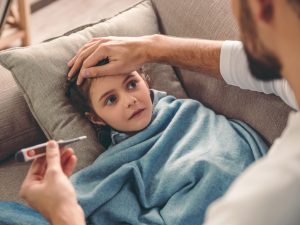In this Article
- What Are Bacterial Infections in Children?
- Causes and Types of Bacterial Infections in Kids
- Signs and Symptoms of Bacterial Infections in Babies and Children
- Diagnosis of Bacterial Infections
- Prevention of Bacterial Infections
- How to Treat Bacterial Infections in Kids?
- What Are Fungal Infections in Children?
- Different Types of Fungal Infection in Children
- Causes of Fungal Infections
- Common Symptoms of Fungal Infections in Kids
- Treatment for Fungal Infections
- Are Fungal Infections in Children Dangerous?
- Prevention of Fungal Infections
Seasonal infections are common amongst children as they are susceptible to rashes, coughs, and fevers. You may wonder what kind of infection your child may have contracted and chances are – if it’s got anything to do with a runny nose or a cough and fever – it’s a bacterial infection.
What Are Bacterial Infections in Children?
A bacterial infection is the growth of a harmful strain of bacteria within the body, or on the skin. Since a child’s immune system is still being developed, he/she may not have the ability to fight these infections and is more susceptible to being affected.
Causes and Types of Bacterial Infections in Kids
Low immunity and frequent contact with environments where bacteria thrive, such as daycare centres or playgrounds, are primary causes of bacterial infection in children.
Here are the most common types of infections:
- Cold – Denoted by a runny nose, fever, and heightened body temperatures.
- Respiratory Infections – Coughing and infections related to the respiratory tract, such as bacterial bronchitis.
- Intestinal Infections – Bacteria entering the intestinal tracts lead to intestinal infections, resulting in vomiting and diarrhoea.
- Meningitis – A condition resulting from weakened immune systems in children.
- Sepsis – Untreated underlying infections are collectively known as Sepsis.
Signs and Symptoms of Bacterial Infections in Babies and Children
Spotting the signs and symptoms of bacterial infection in babies can help prevent them in the first place. Here’s how you can tell:
- High Body Temperatures – If your child’s body temperature keeps rising (above 101 degrees), it’s a sign of a bacterial infection in the working.
- Prolonged Fever – Fever lasting more than 2 days
- Lack of Appetite – Refusal to eat food or disinterest in having meals
- Irregular Toilet Habits – Lesser urination and frequent passing of stools
- Sleepiness and Lethargy – When your child doesn’t mix with his peers, doesn’t go out and sleeps more often.
Diagnosis of Bacterial Infections
Sometimes it’s difficult to tell whether the infection is bacterial or viral. Doctors diagnose bacterial infections through tissue samples and blood sample analysis for children. A rapid detection test is carried out at the clinic and samples are analysed under a microscope for further inspection. In cases when the bacteria are too small to identify, doctors grow them in the laboratory as cultures for analysis. Turning bacteria into culture takes around 24 to 48 hours in the lab.
Prevention of Bacterial Infections
Here are a few ways you can prevent bacterial infection in babies and children:
- Washing Hands – Most antibacterial soaps these days are ineffective since bacteria have become resistant to them. Washing hands with plain water before and after meals, which includes restroom use as well, helps.
- Use Antibacterial Sanitizers – Always carry a pocket-sized anti-bacterial sanitizer on the event you need to sanitize your hands due to dirt and dust exposure.
- Clean Cuts – Don’t leave cuts open and treat them with soap and water.
- Proper Hygiene Habits – Teach children proper hygiene habits, including covering their mouth when they are sneezing or coughing.
How to Treat Bacterial Infections in Kids?
Antibiotics will be prescribed by the doctor for your child if he/she has a bacterial infection. Be sure to make your child take the right doses of antibiotics at right times of the day to eliminate bacterial infections. Talk to the doctor or healthcare provider and listen to their advice carefully, since bacterial infections are often confused with viral infections by parents and antibiotics are not appropriate for the latter.
What Are Fungal Infections in Children?
Fungal infections are a type of infection that affect children with immunocompromised systems. All fungi are not pathogenic and most fungi take advantage of the host’s physical health condition to develop into an infection. Fungi infections can live inside the body, outside, and penetrate into the deeper parts of the biological system.
Different Types of Fungal Infection in Children
There are different types of fungal infection in children based on the way they affect them. They are:
- Tinea Capitis/ Scalp Ringworm – This is a fungal infection in children which affects the scalp and hair shafts. It begins with a small red circle on the skin which grows outward into a ring. It is symptomized by itchy patches on the scalp accompanied by hair breakage.
- Athlete’s Foot – Usually affects the sides of the toes, but can affect the bottom of the feet as well as the toenails.
- Tinea Corporis/ Body Ringworm – This fungal infection appears as a circle-shaped rash on different parts of the body excluding the soles of the feet, the palms of the hand, groin and scalp. It is caused by dermatophytes
- Jock Itch – Affects the groin and upper thigh areas. It affects both men and women.
- Candida- This is a type of fungal nail infection in children which affects the skin around the nails and are often found in patches on babies’ mouths. Fungal infection in and around the women’s vagina is known as yeast infection. Diaper rash and thrush for babies fall under infection type Candida.

Causes of Fungal Infections
The common causes of fungal infections in children are:
- Lack of Breathability of the Child’s Clothes – Your child may be wearing tight-fitting clothing which does not provide enough breathability, exercising, or sweating a lot in the summers. This causes moisture to build up and create a damp environment which is the perfect breeding ground for fungal infections.
- Sharing Reused Towels – Fungi lives on for days and grows in moist areas. Sharing reused towels spreads the infection from one skin type to another.
- Inflammatory Infections – Your child’s immune system becomes weakened and hormonal levels go out of balance due to inflammatory infections due to the body starting up its inflammatory response incorrectly. This leads to fungal infections.
Common Symptoms of Fungal Infections in Kids
Here are a few symptoms of fungal infections:
- A fungal infection on baby skin may appear as a rash with raised edges
- It may cause itchiness
- Peeling and cracking skin
- It may cause pain on the infected part of the body
- Scalp infection may cause hair-loss
- Infection may cause discolouration and crumbling of toenail and fingernails
Treatment for Fungal Infections
If your child has a fungal infection, consulting a doctor and getting an antifungal cream prescribed is a start. Apply the antifungal cream for one to two weeks and do not send your child to school as the infection can spread. If antifungal creams don’t work, your child’s doctor may prescribe antifungal tablets. Encourage your child to stop scratching the affected area and make sure they wear breathable clothing fabricated from cotton or similar material which prevents moisture-buildup round the affected areas of the skin. Wait for 48 hours until the fungal infection treatments work its way in before sending your child back to school.
Are Fungal Infections in Children Dangerous?
Yes. Fungal infections in babies and kids, if left untreated, are dangerous and can even lead to death in the long run due to compromised immune systems and weakening inflammatory response.
Prevention of Fungal Infections
By preventing fungal infections in the first place, you ensure your child’s wellbeing. Here are a few ways you can prevent fungal infections from occurring in children:
- Make children stay away from affected pets and people – Fungal infections spread from one person to another, and even from animals to humans. Make sure your child stays away from affected beings.
- Ensure proper hygiene– Wash their hands and feet regularly. Dry them properly after washing and make sure they clip their toenails and fingernails to reduce chances of fungal infections. Parents should also practice good hygiene routines to ensure they don’t get affected as well since fungal infections are transferable.
- Wear appropriate footwear– Wearing the right footwear can prevent fungal infections from contracting on their feet in the first place.
- Wear flip-flops or sandals at public pools and during shower times.
- Keep homes clean and dry – Make sure your home is clean and dry. Eliminate wet and damp areas on the floor since babies crawl a lot and can get affected by fungal infections from there.
Although fungal and bacterial infections in children can be cumbersome and at times, life-threatening, you can take simple measures for maximum results and prevent them from happening in the first place. If your child has an infection, either bacterial or fungal, in their mild stages, get them treated immediately by consulting a doctor and getting prescribed the correct antibiotics with the right dosages. Practice proper hygiene, avoid moist and damp areas, incorporate a healthy diet, wear the right clothing and footwear and your child will say goodbye to fungal and bacterial infections.










